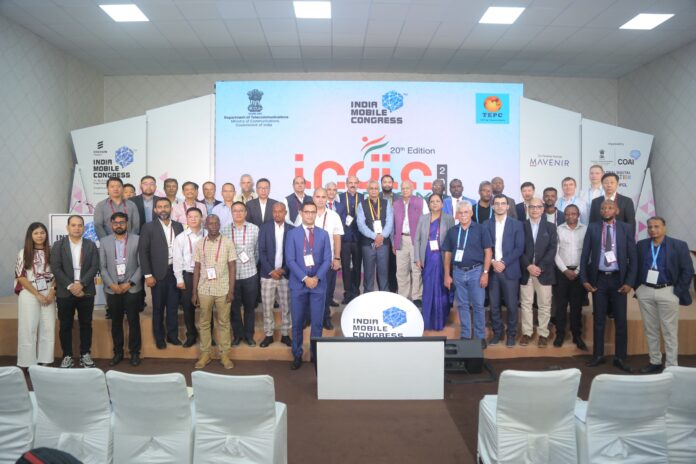New Delhi, 28th October 2023: The 7th Edition of Indian Mobile Congress (IMC) 2023, the largest telecom, media and technology forum in Asia, jointly organized by the Department of Telecommunications (DoT) and the Cellular Operators Association of India (COAI), entered in 2nd day showcasing futuristic technologies and India’s digital and telecommunication prowess with a range of emerging innovations. Aligning with this year’s theme, “Global Digital Innovation”, the second day of India Mobile Congress 2023 witnessed key industry leaders from telecom and technology companies. The Department of Telecom officials participated in a range of panels discussions including Industry 4.0, 5G Applications, Enterprise Digital Transformation, Sustainable Development, Monetizing Connectivity, Role of India in Global semiconductor landscape, 6G standardization, etc. The exhibition also continued to witness showcases by exhibitors and their innovative technologies & ideas, while discussion kept on going to pave the path to a sustainable and greener future.
During IMC 2023 more than 400 Speakers are participating in panel discussions, sharing their insights over 80 sessions, to be conducted in 7 Conference halls, spread over a period of these three days. The second day featured sessions that included further discussion on the path to innovation and entrepreneurship with insights from other prominent industry leaders.
Quotes from key industry leaders on Day 2 of India Mobile Congress 2023.
Dr. Thiaw Seng NG, Head of NS Network Evolution, South East Asia , Oceania and India , Ericsson, Said,” Fixed Wireless Access (FWA) is poised to disrupt the fixed broadband market, with over 100 service providers now offering FWA over 5G. New possibilities with network slicing, such as event slicing and slicing with enterprises, will drive enhanced services. XR will also play a role in driving innovation, with AR glasses set to become bigger than smartphones. 5G low-cost, low-power devices will bring down complexity and extend battery life, while delivering high data rates and speeds. In India, 5G is enabling new services such as 3D/AR digital libraries, immersive replays, hologram messaging, and optimized mobile gaming.
According to Ganesh Lakshminarayanan, CEO, Airtel Business, Said, “4G did transform our lives. Today, we cannot imagine living without data. Work from home was a killer 4G use case and our hope is that such killer 5G use cases are also round the corner. We have high expectations from FWA – Airtel has launched the solution and we will be focusing on scaling it going ahead. We are also seeing some green shoots from the B2B sector but there are no killer use cases in the B2C sector as of now.”
Vimal Kumar, Vice President & Global Head – Network Solutions & Services Unit at Tata Consultancy Services said,” The future is here and now, and innovation is key to driving economic value and creating value for the masses. India is on the cusp of becoming a leader in 6G standards, and the government’s policy framework must support the growth of innovation and create a healthier ecosystem. The policy framework is really supporting the growth of this innovation and really supporting the charter for innovation. In some cases, all I’m recommending is the policy framework has to be a live document, which looks at these numbers in a regular manner and see if these policies are creating enough economic push, so that you can create a healthier ecosystem.”
Sanjay Malik, Senior Vice President, Head of India Market, Nokia, said, “India has transformed from being a tech consumer to a tech creator in the last decade. This is due to a number of factors, including the change in Indian mindset, government policies, industry support, and the availability of tech manpower and youth population. Today, India is a digital powerhouse, and its tech prowess is sought by developed countries around the world. The country has made significant progress in financial inclusion, which would have taken decades to achieve without digitalization. India is also at the forefront of technological innovation. Nokia has accelerated its manufacturing and R&D activities in India and has set up a 6G lab to test and develop end-to-end solutions. India is well-positioned to drive global innovation forward in the coming years.”
Julian Gorman, Head of Asia-Pacific, GSMA said, “Over the last five years, India has set a remarkable example on the global stage. With 5.4 billion unique mobile subscribers worldwide and over 1 billion 5G connections by the end of 2022, the future is promising. By 2030, Asia Pacific is projected to host 1.4 billion 5G connections, contributing significantly to GDP. The key to this transformation lies in affordable smartphones, facilitating the creation of digital nations, an imperative for our times. We are also working towards refining regulations and policies to ensure equitable access. The mobile industry has revolutionized our way of life, and at its core, it thrives on innovation and creativity.”
Savi Soin, President, Qualcomm said,” Qualcomm has more people working in India than anywhere in the country. We have set to design in India, deploy in India then Scale across the globe. What India has done with UPI, is unbelievable and is a case study in itself, that’s the beauty of it. India has emerged as the GCC hub for global corporations and make in India is a great initiative for the phone market. Qualcomm’s unique business model enables ecosystem to support design in India and ‘Make in India’ making us the enablers of the industry. NavIC is one such success story”.
Marshal Correia, Vice President and General Manager, India, South Asia, Red Hat said, “Digital transformation was always on the agenda, but COVID changed everything overnight. All the apps had to be available on mobile. Today enterprise customers are becoming factories. Look at banking, look at the transformation– UPI, digital currency, many innovations have been made. At RedHat, we work with upstream and then downstream communities. It’s not about building technology, it’s about building apps. Most of the apps made overnight like CoWin, work on open source.”
Manoranjan ‘Mao’ Mohapatra, CEO, Comviva said, “Innovation is closely linked to the willingness to take risks. Organizations that encourage risk-taking and embrace fail-fast are the true drivers of innovation. It’s easy to replicate what’s already proven, but it takes courage to explore fresh frontiers. Telcos are grappling with a shrinking gap between each generation (3G to 4G, 4G to 5G, and now to 6G) while facing skyrocketing investments. However, returns are not keeping pace, and revenues are declining. With the same revenue, they are serving more customers and handling a larger data volume. Without sufficient resources for R&D and transformative initiatives, telcos’ ability to innovate is hindered.”
In a notable addition to this year’s India Mobile Congress 2023, the event also introduced ‘Aspire’, a pioneering start-up program & ‘Robo Blitz’, a robo wars event for the first time. While Aspire laid emphasis on igniting the future of entrepreneurship growth among young innovators and industry delegates in the telecom and other digital domains; Robo Blitz competition invited young engineers and technology enthusiasts who demonstrate their skills in robotics. As the India Mobile Congress continues to be a significant venue for technological advancement, the inclusion of Robo wars and Aspire underscores the event’s broader commitment to fostering skill development and creativity for the emerging generation.
The three-day-long exhibition is poised to highlight India’s expertise in emerging & cutting-edge technologies such as 5G, 6G, AI, manufacturing, semiconductors, cybersecurity, broadcasting, satellite, green technology, deep tech, etc. The exhibition is being organized in the Exhibition Hall no. 2-5 from October 27th to 29th.
Views: 0


